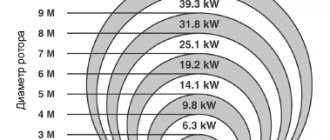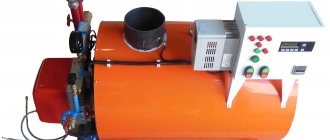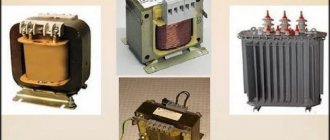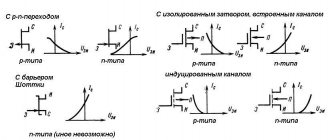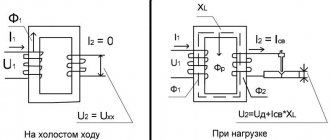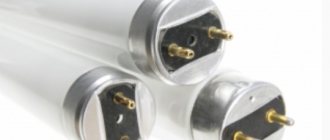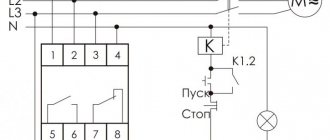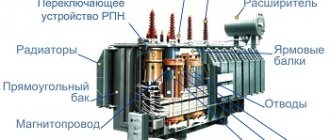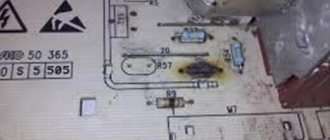A modern kinetic wind generator allows you to take advantage of the power of air currents, converting it into electricity. For this purpose, there are factory-made and home-made models of devices that are used both in industry and in private households.
We will tell you how wind turbines of this type are designed, and introduce you to the features of the device and design options. The article we have proposed shows the strengths and weaknesses of a wind power plant. Do-it-yourselfers will find useful diagrams and assembly recommendations here.
Wind generator operating principle
The operation of a wind generator is based on the transformation of the kinetic energy of the wind into the mechanical energy of the rotor, which is then converted into electricity.
The principle of operation is quite simple: the rotation of the blades fixed to the axis of the device leads to circular movements of the rotor generator, thereby generating electricity.
Wind energy is one of the most promising sectors of renewable energy. Modern designs make it possible to cost-effectively harness the power of air currents, using it to generate electricity
The resulting unstable alternating current “drains” into the controller, where it is converted into direct voltage that can charge the batteries. From there, the power is supplied to the inverter, where it is transformed into an alternating voltage with an indicator of 220/380 V, which is supplied to consumers.
The power of a wind generator directly depends on the power of the air flow (N), calculated according to the formula N=pSV3/2, where V is the wind speed, S is the working area, p is the air density.
Increasing the power of the installation
Some wind generators are designed with a wind sensor. It collects data on the direction and speed of air flow. A windmill generator cannot produce more than its rated power, however, any equipment contains a reserve that can range from 10-30% of the calculated one. You should not count on this “reserve”, since overload protection is built into the wind generator programmatically and structurally.
The power of a wind turbine can be increased using a battery-based power backup system.
The output power (kW) of the wind generator is determined by the power of the inverter. Based on the kilowatts supplied, you can determine the maximum number of connected electrical appliances. To increase the output power of the installation, it is necessary to connect several inverters in parallel.
For three-phase power supply circuits, it is necessary to install an inverter for each phase.
If the power in the phase is not enough, increase the number of inverters, if provided by the manufacturer. If there is no wind, the power supply will stop running. There is no energy generation, so energy storage devices are connected to the wind generator, see the diagram below.
Scheme for increasing the power and capacity of a wind generator
The energy storage device consists of an inverter-battery combination. You can read about batteries in this section, and about storage devices in this one. Increasing the capacity of rechargeable batteries increases the amount of stored energy, but also the charging time. The battery charging speed depends on the power of the generator and the number of inverters, which can also pass through only the power provided by the manufacturer. Accordingly, the battery charging speed depends on the throughput of the inverter and does not depend on the power of the wind generator .
Wind generator device
Various versions of wind generators differ significantly from each other.
The diagram below shows the internal structure of a classic horizontal wind generator. Such models are most often used both in industry and in everyday life.
Industrial devices are a complex multi-meter structure, the installation of which requires a foundation, while a household model can consist of a minimum of components (DC electric motor 3-12V, electric capacitor 1000 uF 6V, silicon rectifier diode).
A typical installation includes the following components:
- alternating current generator (power depends on the speed of wind flows);
- blades that transmit rotation to the generator shaft (often they are additionally equipped with gearboxes and rotor speed stabilizers);
- the windmill mast to which the blades are attached (the higher these elements are, the more wind energy they can receive);
- batteries that store energy, allowing it to be used when there is little or no wind flow. The battery also performs the function of stabilizing the electrical energy supplied from the generator;
- controller - converter of alternating voltage received from the generator into direct voltage, which is used to charge the battery. The controller is controlled by turning the blades, which allows you to take into account where the air flows are moving;
- AVR is an automatic switching device that connects the wind generator with other energy sources (solar panels, power grid);
- wind direction sensor - a device that makes it easier for the blades to find the wind flow;
- an inverter for converting direct current from batteries into alternating voltage, which is used in electrical communications.
To better meet user needs, the device can be equipped with various types of inverters:
- devices with an inverter-modified sine wave that produces a square sine wave. Devices of this type are suitable for heating elements, incandescent lamps and other devices that are undemanding to network quality;
- three-phase voltage inverters designed for three-phase electrical networks;
- pure sine wave units that produce energy for more sensitive equipment;
- network inverters that can operate without batteries. Such devices are designed for circuits that involve electrical energy entering directly into the general network.
When choosing models, be sure to pay attention to the type of inverter.
Generator for wind turbine
Wind turbines require conventional three-phase generators to operate. The design of such devices is similar to models used on cars, but has larger parameters.
Wind turbine instruments have a three-phase stator winding (star connection), from which three wires come out and go to the controller, where the alternating voltage is converted to direct voltage.
The generator rotor for a wind turbine is made of neodymium magnets: in such designs it is inappropriate to use electrical excitation, since the coil consumes a lot of energy
A multiplier is often used to increase turnover. This device allows you to increase the power of the existing generator or use a smaller device, which reduces the cost of installation.
Multipliers are more often used in vertical wind generators, in which the process of rotating the wind wheel is slower. For horizontal devices with high blade rotation speeds, multipliers are not required, which simplifies and reduces the cost of the design.
The specifics of assembling and installing a wind generator from a washing machine and a wind turbine from a car generator are described in detail in the articles we recommend.
Installation of wind generators
One of the necessary conditions for the full operation of the device is the choice of a suitable location for its placement. Ideally, this should be a high ground with high wind speeds and low turbulence.
If there is a forest nearby, this will reduce the efficiency of the wind generator. The absence of overhead power lines nearby will not make it possible to redirect the generated electricity to consumers.
Problems caused by the operation of wind power plants
Despite the fact that wind turbines are a promising way to generate electricity, there are many problems associated with their operation. In particular, in European countries where wind energy is being actively introduced, many people complain about the discomfort caused by the close proximity to wind turbines.
In most countries there are no laws that would clearly define at what distance from residential buildings they can be placed. Sometimes a wind generator can be seen already at a distance of 200-250 meters from the house. People complain about loud noise that can be heard hundreds of meters around. The shadow from the rotating blades of a windmill can be cast for several kilometers. This causes severe psychological discomfort.
The problems are caused by the fact that the full-scale use of wind energy began relatively recently. Powerful wind generators have not been used before. Therefore, their full impact on humans has not been studied. Currently, laws are being developed to minimize the discomfort from the operation of these mechanisms.
If you find an error, please select a piece of text and press Ctrl+Enter.
Pros and cons of a wind generator
Let us consider in detail the advantages and disadvantages of wind turbines, since the decision to purchase a wind turbine or abandon it depends on them.
Advantages of wind devices
The advantages of devices using wind energy include:
- Environmentally friendly. The installations use a renewable energy source that can be used continuously without causing damage to the environment. Electricity generated by wind generators replaces the energy of thermal power plants, reducing greenhouse gas emissions.
- Versatility . Wind power plants can be built almost everywhere: on plains, in mountains, in fields, on islands and even in shallow waters. Wind energy is especially valuable in remote places where it is difficult to extend conventional electrical communications. Wind generators in this case make it possible to establish an energy supply for objects, ensuring its independence from random factors (for example, fuel not delivered on time).
- Efficiency of use . Modern models process the energy of even weak winds - the minimum limit is 3.5 m/s. In this way, it is possible to supply additional electricity to the centralized network, as well as organize power supply to individual objects (island or local) regardless of their power.
- A worthy alternative to traditional sources. Stationary wind power plants can completely provide electricity to a residential building or even a small industrial facility. In this case, the turbine will accumulate the required supply of electricity in batteries, intended for use during calm periods.
- Economical. Compared to traditional sources of electrical energy (gas, peat, coal, oil), bicycle turbines can significantly reduce energy costs. In many cases, building a wind farm is cheaper than connecting to existing power systems.
The use of wind turbines can be an alternative to the use of expensive diesel generators, further reducing the costs of transportation and storage of fuel by up to 80%.
The average power of a wind turbine differs several times from the peak load. A wind generator is responsible only for the amount of energy produced over a certain period of time at the average monthly wind speed characteristic of a given area.
For a more accurate assessment of wind resources, you can use specially derived data (Weibull parameters). These indicators reflect the distribution of winds of different strengths characteristic of a particular area. It is important to take such information into account when developing wind farm projects with a capacity of tens of MW.
The power generated by a wind turbine is proportional to triple the wind speed. Consequently, this indicator is very small when wind flows are weak, but when they intensify, it increases sharply. Due to the variability of wind direction and speed, stabilizing components must be included in the design of a wind turbine.
The rules and formulas for calculating the power of a wind generator are given here; we recommend that you familiarize yourself with the very useful information.
In small autonomous systems, their function is performed by batteries, the charge of which begins to increase as soon as the power of the wind generator exceeds the load.
As the load increases, the battery may discharge. It is important to take this feature into account when choosing a household unit; its power must match the monthly or annual electricity consumption rate
It should be noted that the effective use of wind flows is facilitated by a variety of wind generator designs.
Horizontal turbines perform well in flat areas where there is a lot of wind, while vertical turbines work better in regions with turbulent flows found low to the ground (upper hills, mountain ranges).
The main disadvantages of wind turbines
At the same time, wind turbines also have their negative sides:
- The magnitude of the wind force is difficult to predict in advance, as it changes frequently. Because of this, it is advisable to consider a safety net by providing a backup energy source (solar panels, connection to the electrical network).
- Vertical devices are at risk of destruction of the propeller blades due to the effects of centrifugal forces when the blades rotate around the main axis. As a result of this effect, important structural elements become deformed and destroyed over time, and the mechanism fails.
- It is better to install wind turbines in free space, since nearby buildings can “dampen” the wind, forming a “dead” air zone.
- To save excess energy from wind turbines, it is necessary to include in the design the use of batteries and other additional devices that serve to convert the generated electricity into current with suitable consumer characteristics.
- When operating, wind generators produce noise that can cause discomfort to people and scare away animals. The blades of the installations can also cause the death of birds flying towards them.
- According to some experts, wind turbines can degrade the reception of radio and television broadcasts.
Negative aspects can also include the rather high cost of such units, however, the low cost of the energy source largely offsets this factor.
Connection diagrams and methods
Although a wind turbine can operate autonomously, much better results can be achieved using combined schemes that combine a wind turbine with solar panels, a centralized power grid, diesel or gas energy sources.
Autonomous operation . In this case, a single installation is installed, with the help of which wind energy is captured and accumulated, which is then converted into the electric current needed by consumers.
The diagram shows the simplest way to use a wind generator, which is advisable to use in regions where strong winds constantly blow
Combining a wind generator with solar panels . The combined option is considered a reliable and efficient method of power supply. In the absence of wind, the battery is powered by solar panels, and in cloudy weather and during the night, charging occurs from a wind turbine.
An ideal option for a private home or farm located far from a centralized power grid. This combined scheme allows the use of two types of renewable energy
Combined operation of a wind generator and power grid . A wind turbine can be combined with electrical communications.
This arrangement is typical for industrial and commercial devices. Connection to electrical communications is also provided for some models of household wind generators
If there is an excess of electricity produced, it goes to the centralized network, and if there is a shortage, it is possible to use electric current from the general energy system.
Principle of operation
Next, the rotational force is converted into electricity, which is accumulated in the battery. The stronger the air flow, the faster the blades spin, producing more energy. Since the operation of a wind generator is based on the maximum use of an alternative energy source, one side of the blades has a rounded shape, the other is relatively flat. When the air flow passes over the curved side, a vacuum area is created. This sucks the blade, moving it to the side. This creates energy, which causes the blades to spin.
Diagram of the operation of a wind generator: the principle of converting wind energy and the operation of internal mechanisms is shown
During their turns, the propellers also rotate the axis connected to the generator rotor. When twelve magnets attached to the rotor rotate in the stator, an alternating electric current is created, which has the same frequency as in ordinary indoor sockets. This is the basic principle of how a wind turbine works. Alternating current is easy to generate and transmit over long distances, but cannot be stored.
Schematic diagram of a wind generator
To do this, it must be converted to direct current. This work is performed by an electronic circuit inside the turbine. To obtain large amounts of electricity, industrial plants are manufactured. A wind farm usually consists of several dozen installations. By using such a device at home, you can achieve a significant reduction in energy costs. The operating principle of wind generators allows them to be used in the following options:
- for autonomous operation;
- in parallel with the backup battery;
- together with solar panels;
- in parallel with a diesel or gasoline generator.
If the air flow moves at a speed of 45 km/h, the turbine produces 400 W of electricity. This is enough to illuminate a summer cottage. This power can be accumulated by collecting it in a battery.
A special device controls the charging of the battery. As the charge decreases, the rotation of the blades slows down. When the battery is completely discharged, the blades begin to rotate again. In this way, charging is maintained at a certain level. The stronger the airflow, the more electricity the turbine can produce.
Nuances of using wind generators
Currently, wind turbines are used in various sectors of the national economy. Industrial models of varying capacities are used by oil and gas, telecommunications companies, drilling and geological exploration stations, production facilities and government agencies.
The wind turbine can be used as an additional source of energy in hospitals and other institutions to ensure continuous power supply in emergency situations
Particularly noteworthy is the importance of using wind turbines for the prompt restoration of damaged electricity during cataclysms and natural disasters. For this purpose, wind generators are often used by units of the Ministry of Emergency Situations.
Household wind turbines are perfect for organizing lighting and heating in cottage communities and private houses, as well as for economic purposes on farms.
There are some points to consider:
- Devices up to 1 kW can provide a sufficient amount of electricity only in windy places. Typically, the energy they generate is only enough to power LED lighting and power small electronic devices.
- To fully provide electricity to a dacha (country house), you will need a wind generator with a power of over 1 kW. This indicator is enough to power lighting fixtures, as well as a computer and a TV, but its power is not enough to supply electricity to a modern refrigerator that operates around the clock.
- To provide energy to a cottage, you will need a wind turbine with a capacity of 3-5 kW, but even this figure will not be enough to heat houses. To use this function, you need a powerful option, starting from 10 kW.
When choosing a model, you should take into account that the power indicator indicated on the device is achieved only at maximum wind speed. Thus, a 300V installation will produce the specified amount of energy only at an air flow speed of 10-12 m/s.
For those wishing to build a wind generator with their own hands, we offer the following article, which contains useful information in detail.
Development of wind energy in the world and in Russia
Developed countries are leaders in the construction of wind power plants. Germany and European countries in general are ahead of the rest of the planet. There are wind farms in the Scandinavian countries and southern Europe. In the Asian region, China is the leader in the use of wind energy. Many of their building construction projects involve the installation of wind generators in them.
There are wind power plants in several regions of Russia
In America, both South and North, wind power plants have been used for several decades to provide electricity to homes and farms. Here they managed to displace traditional energy sources. The United States receives approximately 1/5 of all wind energy on the planet.
In Russia, in recent years, the construction of wind power plants has also been underway. There are several regions where they were built:
- Bashkortostan (Tyulkildy station);
- Kalmykia (Kalmyk wind farm);
- Kaliningrad region (Zelenograd wind farm);
- Crimea. There are 5 stations on the peninsula, of which are very large;
- Murmansk;
- The Republic of Sakha (Yakutia.
The growth in the use of wind energy in the country is not as intense as in Western countries, but positive dynamics are observed. Experts predict a further increase in capacity. In Western countries, more and more budget funds are being spent on this for the development of alternative energy. Including the construction of wind power plants. They consider it especially important that such installations do not pollute the environment.
Conclusions and useful video on the topic
The video below provides detailed information about the operating principle and design of a household model of a wind generator:
A wind generator is an excellent source of electrical energy production, which will be especially appreciated by residents of remote areas. Various Russian and foreign enterprises offer a wide range of wind structures; in addition, household models can be made with your own hands.
Please write comments in the block below. Tell us about how you built a wind generator on your property, or about how your neighbors’ wind turbine works. Ask questions, share useful information and photos on the topic.
